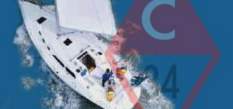Stu,
After 12 wonderful years sailing our 1990 C-34 Pleiades throughout New England waters - from Maine to NY - I am now 84 and Nancy is 73. After much back-and-forth discussion we finally decided rather than sell our beloved C-34 we will give her to our son and daughter-in-law and their three boys ages 10, 7 and 5. They live in Petosky, MI. Since he is a master shipwright at Irish Boat Shop in Harbor Springs, MI, Andrew certainly should be more than capable of maintaining her in excellent condition. Hopefully, she will provide them with many years of wonderful sailing, a wide range of adventures, and memories to last five lifetimes.
I have a current subscription to Mainsheet that I believe extends through 2025. Please contact me at pfjacobs@verizon.net so I can forward Andrew's name, and mailing address, so you can transfer my Mainsheet subscription to him. As new owners of a lovely C-34 I am sure they will very much enjoy reading the magazine.
Nancy and I decided that while we love sailing too much to quit altogether, at our ages it was important to "downsize". Thus, a good friend and former partner in our C-30 "Clair de Lune" and Nancy and I collectively purchased a classic 1964 Graves Constellation (29 ft. 5 in LOA, 8 ft. beam, 4.5 ft. draft, 6000 lb. displacement) that was in fundamentally sound condition but needed considerable cosmetic attention. We are about 1.5 years into her restoration and hope to be sailing her on Narragansett Bay this coming summer.
After 12 wonderful years sailing our 1990 C-34 Pleiades throughout New England waters - from Maine to NY - I am now 84 and Nancy is 73. After much back-and-forth discussion we finally decided rather than sell our beloved C-34 we will give her to our son and daughter-in-law and their three boys ages 10, 7 and 5. They live in Petosky, MI. Since he is a master shipwright at Irish Boat Shop in Harbor Springs, MI, Andrew certainly should be more than capable of maintaining her in excellent condition. Hopefully, she will provide them with many years of wonderful sailing, a wide range of adventures, and memories to last five lifetimes.
I have a current subscription to Mainsheet that I believe extends through 2025. Please contact me at pfjacobs@verizon.net so I can forward Andrew's name, and mailing address, so you can transfer my Mainsheet subscription to him. As new owners of a lovely C-34 I am sure they will very much enjoy reading the magazine.
Nancy and I decided that while we love sailing too much to quit altogether, at our ages it was important to "downsize". Thus, a good friend and former partner in our C-30 "Clair de Lune" and Nancy and I collectively purchased a classic 1964 Graves Constellation (29 ft. 5 in LOA, 8 ft. beam, 4.5 ft. draft, 6000 lb. displacement) that was in fundamentally sound condition but needed considerable cosmetic attention. We are about 1.5 years into her restoration and hope to be sailing her on Narragansett Bay this coming summer.
